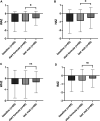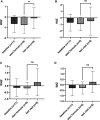Symptom's resolution and growth outcome of children with cow's milk protein allergy consuming two hydrolyzed formulas: A retrospective study in Mexico
- PMID: 36793546
- PMCID: PMC9922738
- DOI: 10.3389/falgy.2023.1073430
Symptom's resolution and growth outcome of children with cow's milk protein allergy consuming two hydrolyzed formulas: A retrospective study in Mexico
Abstract
Background: Cow's milk protein allergy (CMPA) is the leading cause of food allergy in infants and young children. An extensively hydrolyzed formula (eHF) is the first choice of dietary management, however, not all of them have similar peptide profiles and degree of hydrolysis. The aim of this retrospective study was to investigate the use of two commercially available infant formulas in the clinical management of CMPA in Mexico in terms of symptoms' resolution and growth trajectories.
Methods: Medical records of 79 subjects from four sites in Mexico were included to retrospectively evaluate the trajectory of atopic dermatitis, other symptoms of cow's milk protein allergy and growth outcomes. The study formulas were based on hydrolyzed whey protein (eHF-W) and hydrolyzed casein protein (eHF-C).
Results: Medical records of 79 patients were enrolled, 3 were excluded from analysis based on previous formula consumption. Seventy-six children with confirmed CMPA based on skin prick test and/or serum specific IgE levels were included in the analysis. 82% of patients (n = 65) consumed the eHF-C, reflecting the doctors' preference for formulas with a higher grade of hydrolysis and the high incidence of positive reactions to beta-lactoglobulin amongst subjects. During their first visit to the doctors, 55% of the subjects consuming the casein-based formula and 45% of subjects consuming the whey-based formula presented with mild or moderate dermatological symptoms. Other frequently reported symptoms included respiratory issues, enteropathies and colitis which improved during the consumption of both formulas. All CMPA-related symptoms showed improvement during formula consumption. During the period of retrospective observation, growth significantly improved for both groups.
Conclusion: Consumption of eHF-C and eHF-W effectively improved symptoms' resolution and growth outcomes among children with CMPA in Mexico. More preference was reported towards eHF-C due to its hydrolysate profile and lack of b-lactoglobulin.
Trial registration: The study was registered at ClinicalTrials.gov: NCT04596059.
Keywords: Mexico; SCORAD; cow's milk protein allergy; growth; hydrolysates; infant formula.
© 2023 Estrada Reyes, Zepeda Ortega, ten Haaf, Kudla, Muhardi, Hofman, Hageman and Huerta Hernández.
Conflict of interest statement
DLH, UK, LM, DH, and JH are employees of FrieslandCampina at the time of trial execution and manuscript submission.
Figures



Similar articles
-
Safety and efficacy of a new extensively hydrolyzed formula for infants with cow's milk protein allergy.Pediatr Allergy Immunol. 2008 Jun;19(4):348-54. doi: 10.1111/j.1399-3038.2007.00653.x. Epub 2007 Dec 19. Pediatr Allergy Immunol. 2008. PMID: 18167160 Clinical Trial.
-
Efficacy of an extensively hydrolyzed formula with the addition of synbiotics in infants with cow's milk protein allergy: a real-world evidence study.Front Allergy. 2023 Oct 9;4:1265083. doi: 10.3389/falgy.2023.1265083. eCollection 2023. Front Allergy. 2023. PMID: 37876766 Free PMC article.
-
World Allergy Organization (WAO) Diagnosis and Rationale for Action against Cow's Milk Allergy (DRACMA) guideline update - XI - Milk supplement/replacement formulas for infants and toddlers with CMA - Systematic review.World Allergy Organ J. 2024 Sep 10;17(9):100947. doi: 10.1016/j.waojou.2024.100947. eCollection 2024 Sep. World Allergy Organ J. 2024. PMID: 39310372 Free PMC article.
-
Efficacy and safety of hydrolyzed rice-protein formulas for the treatment of cow's milk protein allergy.Arch Pediatr. 2019 May;26(4):238-246. doi: 10.1016/j.arcped.2019.03.001. Epub 2019 Apr 9. Arch Pediatr. 2019. PMID: 30979632 Review.
-
Hydrolyzed rice formula for dietary management of infants with cow's milk allergy.World Allergy Organ J. 2022 Nov 17;15(12):100717. doi: 10.1016/j.waojou.2022.100717. eCollection 2022 Dec. World Allergy Organ J. 2022. PMID: 36438193 Free PMC article. Review.
References
Associated data
LinkOut - more resources
Full Text Sources
Medical

